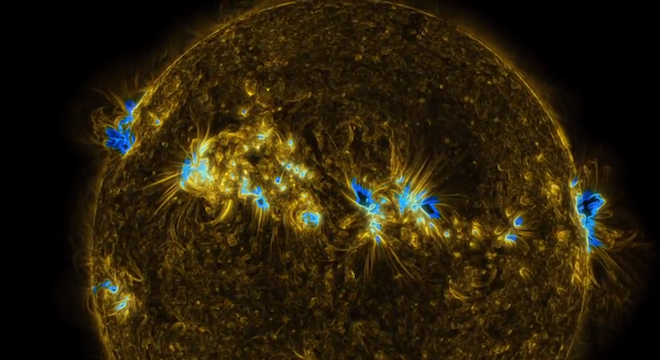Updated 11:13 a.m., Friday, May 25
Missed the annular solar eclipse that occurred on May 20? Don’t feel bad, NASA has released a gorgeous new video of a sight even rarer: the Sun’s surface, up close and as you’ve never seen it before.
The video is actually a collection of still images of the Sun collected by NASA’s Solar Dynamics Observatory (SDO), an unmanned orbital spacecraft launched in February 2010 specifically to track the Sun’s activity and better understand its causes and effects on Earth.
The video is made up of images of the Sun’s plasma activity captured by SDO’s instruments, activity that would otherwise be invisible to the naked eye, as it is seen only in an ultraviolet wavelength (171 Angstrom).
The images that make up the video captured a particularly intense 24-hour period of activity on the surface of the Sun from September 25 to September 26, when several coronal mass ejections — bursts of charged particles that often occur along with solar flares — and solar “tornadoes” swirled around the star’s surface.
The video’s creator, NASA Goddard Space Flight Center producer Scott Wiessinger, told TPM that it took him nearly as long — around 25 hours — to create the video, but hopes it will be well worth the time spent.
“I made the video because I thought the effect looked really neat and other people might like seeing it too,” Wiessinger wrote in an email to TPM. “From a broader perspective, I’d love it if viewers who enjoyed watching the video were motivated to look up other SDO footage, find out more about spacecraft, or learn more about what features and activity they are seeing in the video. Video isn’t necessarily the best medium for teaching, but it is a great one for creating an emotional response and motivating.”
Specifically, Wiessinger said that he used Adobe Photoshop’s “glowing edges” filter to every frame of the video.
“It ended up working even better than I had hoped,” Wiessinger said.
And as for those still pining over the eclipse, don’t worry, NASA has you covered there too, with a video of that annular event from the view of its Hinode spacecraft.
Correction: This post originally incorrectly characterized the May 20 eclipse as “annual,” when in fact, the correct term is “annular,” meaning the moon did not completely cover the Sun. The error has since been corrected in copy and we regret it.






